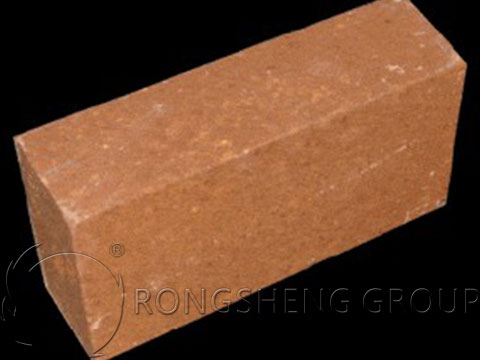Magnesia brick is a common refractory brick product among refractory lining materials. In its practical application, we should give full play to its advantages and avoid its disadvantages. So what are the performance characteristics of magnesia bricks? In actual use, what should be paid attention to? Also, why are magnesia bricks afraid of water? As a refractory manufacturer with rich experience in production and sales, Rongsheng refractory manufacturer will answer these doubts for you.

What are the Performance Characteristics of Magnesia Bricks?
The refractoriness of magnesia bricks can reach more than 2000 ℃, and its load softening temperature varies greatly with the melting point of the cementitious phase and the number of liquid phases produced at high temperatures. Generally, the load softening temperature of MgO bricks is between 1520 and 1600℃, while high-purity magnesia bricks can reach 1800℃. The load softening start temperature of the magnesia brick is not much different from the collapse temperature. The linear expansion rate of magnesia brick at 20~1000℃ is generally 1.2%~1.4%, and it is approximately linear. When a liquid phase appears in the brick at high temperatures, it shrinks suddenly. The thermal conductivity of magnesia bricks is relatively high, second only to carbon bricks and silicon carbide bricks in refractory products, and it decreases with the increase of temperature. The thermal shock resistance of magnesia bricks is poor. Increasing the purity of magnesia refractory bricks can appropriately improve the thermal shock resistance.
What are the Precautions for Using Magnesite Bricks?
The ability of magnesite bricks to resist acid slag is very poor, and they cannot be directly contacted with silica bricks when in use. Generally, neutral bricks should be used to separate them. The conductivity of magnesite bricks at room temperature is very low, but it cannot be ignored at high temperatures (such as 1500°C). If it is used at the bottom of an electric furnace, attention should be paid. The hydration resistance of magnesia refractory bricks is poor, and it is easy to hydrate in contact with water, and cracks will occur, reducing its strength. Therefore, pay attention to moisture, rain, and snow during storage and transportation. So, the last question comes, why are magnesia bricks afraid of water?
Why is Magnesia Bricks Afraid of Water?
Because the MgO component in the magnesia brick reacts with water to form magnesium hydroxide. However, without human intervention, MgO weakly combines with water to form magnesium hydroxide. The degree of reaction is quite low, and it can be considered that it does not react. But in hot water or boiling water, it will react. The chemical equation is MgO + H2O = heating = Mg(OH)2 The reaction must be carried out in hot water. So this reaction depends on the conditions under which it is carried out. The reason for the reaction with water is as follows.
- Magnesium hydroxide produced by the reaction of magnesium oxide and water is a substance that is difficult to dissolve in water. It wraps on the surface of magnesium oxide and inhibits the further reaction of magnesium oxide and water. Although Mg(OH)2 is hardly soluble in water, it is a medium-strong base, so there is always a little dissolved in water, and the amount just generated is particularly small. If the solution is saturated, there will be a small amount attached to the magnesia brick, but it is not visible. Mg(OH)2 must be decomposed above 200 degrees.
- The rate of chemical reaction is closely related to temperature. In general chemical reactions, the higher the temperature, the higher the reaction rate. Another argument is based on the information of “Non-ferrous Metallurgy Furnace” by AR Mikhailenko. The production process of MgO bricks is to mix dead burnt magnesia (particles of less than 5 mm to fine powder) with an appropriate amount of sulfite pulp waste liquid or caustic magnesia as a binder, and press to shape it under a press. The components of magnesia bricks are: metallurgical magnesia, sulfite pulp waste liquid, and caustic magnesia. Metallurgical magnesia is the decomposition of MgO from magnesite above 1600°C. Its composition is: MgO: 92-93.5%, Fe2O3: 1.5-3%, AL2O3: 0.5-3%, CaO: 1-2.5%, SiO2: 2-2.5%. It can be seen from the above composition that Fe2O3, AL2O3, and SiO2 are not hydrolyzed in humid air. MgO exists as periclase crystals and has a very high melting point (approximately 2500). Therefore, no hydrolysis occurs. Only CaO and H2O occur CaO+H2O=Ca(OH)2, so the metallurgical magnesia itself has certain water absorption. The sulfite pulp is a high-molecular viscous colloidal substance, which has hydrophilicity and can make the magnesia brick absorb water in moist air. Caustic magnesite is the decomposition of magnesite at a temperature of 800-900℃ according to MgCO3=MgO+CO2-28900 kcal. This kind of magnesia is just the opposite of the metallurgical magnesia that has been burnt at a high temperature of 1600°C. It is hydrolyzed in moist air: MgO+H2OM→Mg(OH)2. The above reaction just explained the reason why the magnesia brick will be alkalized when encountering moisture and water vapor.
Magnesium and calcium belong to the same family, but the same family does not mean that the properties are exactly the same. The properties of magnesium and calcium are similar, but calcium is much stronger than magnesium. For example, calcium can react violently with cold water, but magnesium can only react with hot water.
After understanding the properties of magnesia refractory bricks, I believe you have a clearer understanding of the storage, transportation, and use conditions of magnesia bricks. Purchase high-quality magnesia brick products to improve the service life of magnesia brick refractory lining. For more solutions of refractory lining materials, please contact Rongsheng refractory manufacturer.
